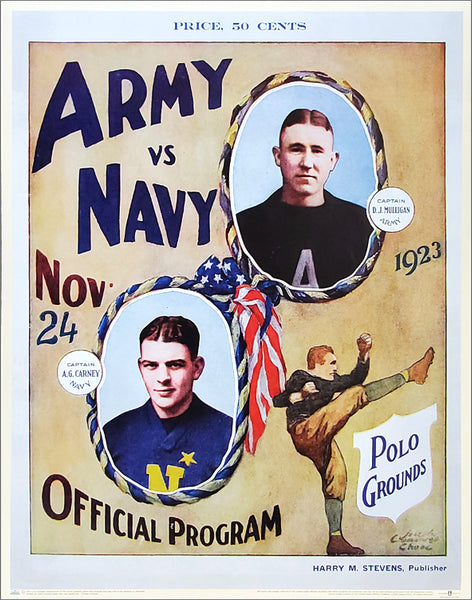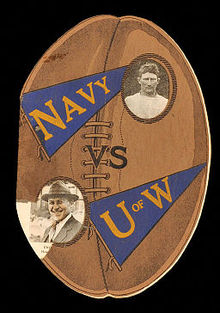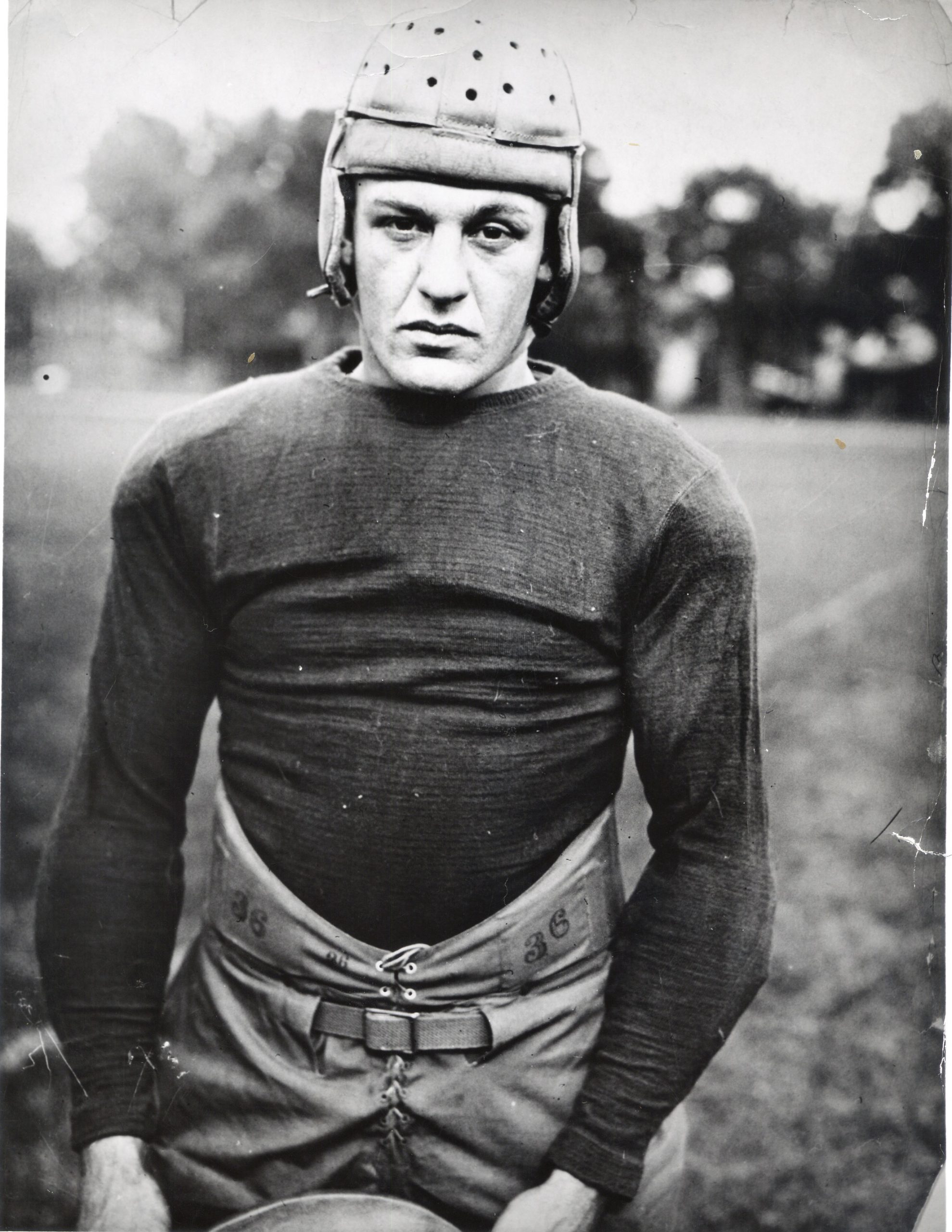FLASHBACK: Illini, Wolverines Lead Nation in 1923
Conference rivals kept pace with one another throughout the 1923 college football season and in the end it was almost impossible to determine a true national champion.
The selectors, whose task it was to pick a national champion, whittled it down to three teams as Illinois and Michigan, both members of the Western Conference were chosen as the top team by multiple selectors after finishing the season at 8-0-0.
The Illini and Wolverines did not meet during the 1923 regular season.
Cornell, meanwhile, competed as an independent in 1923, and the Big Red was retroactively tabbed as the national champion by Sagarin.
Southern Methodist, which has brought the forward pass to the Southwest that season, finished with a 9-0-0 record, but was not in the conversation for the national championship. California (9-0-1), Texas (8-0-1) and Kansas (5-0-3) also went undefeated during the 1923 season.
The season also saw several changes from previous years with the most notable change was Texas Christian being admitted to the Southwest Conference after having spent seasons as an independent. Another big change that season was the University of Washington adopting its current moniker, Huskies, after being the Sun Dodgers prior to 1923.
MICHIGAN WOLVERINES
The Billingsley Report, one of the national champion selectors recognized by the NCAA, selected the Wolverines as the sole national champion, while another selector, the National Championship Foundation selected Michigan and Illinois as co-national champions.
Michigan’s run to the national championship in 1923 was without much trouble as legendary coach Fielding Yost’s team outscored its opponents 150-12 and was only tested three times during the season.
Along the way Michigan extended its unbeaten streak that would eventually reach 20 games.
The winning ways started with a 3-0 win over Illinois on Oct. 29, 1921 in Champaign before tying Wisconsin 7-7 the following week to end the season 5-1-1. The second game of the 1922 season saw Michigan and Vanderbilt battle to a scoreless tie at Dudley Field in Nashville, but the Wolverines won each of the final five games of the season to end with a 6-0-1 record.
The 1923 season and its perfect 8-0-0 record would push the streak to 15-0-2. The undefeated streak would come to a close on Oct. 18, 1924 when Illinois handed the Wolverines a 39-14 setback in Champaign.
After opening the 1923 season against Case Scientific School, the Wolverines passed the first test of the season when they got a field from Jack Blott, the team’s normal center, from the 15-yard line in the second quarter for what turned out to be the only points of the game as Michigan downed Vanderbilt.
According to reports, neither team was prolific on offense on the day. Michigan managed to complete just five of 16 passes for 90 yards. The Commodores, meanwhile, tallied just nine yards through the air after completing just one of five passes on the afternoon. Michigan star halfback Harry Kipke failed on two field goal attempts. His first was blocked and the other came up short and rolled under the cross bar.
Michigan also notched narrow wins against Iowa and Wisconsin to keep its unbeaten streak alive.
Blott was the hero once again when Michigan hit the road for the first time on Nov. 3 to play Iowa, which had tied the Wolverines for the Western Conference championship the previous season. But the 1923 season would be the first meeting between the two teams since 1902 when Michigan, and its Point-a-Minute offense rolled to a 107-0 triumph over the Hawkeyes in Ann Arbor.
Blott stole the headlines in the first quarter with a heads-up play that saw him on both ends of the game-winning points. Blott, a 200-pound center, tossed the ball to teammate Harry Kipke, who punted from midfield. An alert Blott recovered the ball in the end zone after it had grazed an Iowa lineman.
The touchdown put Michigan in front 6-0 and Kipke added a field goal from the Iowa-40 a few minutes later to push the Michigan lead to 9-0.
Iowa’s Fisher added a field goal of his own in the second quarter to put the Hawkeyes to within 9-3 at the time.
It was the first points given up by the Wolverines in 1923.
Again, against Wisconsin, it was a controversial play that proved to work to the advantage of the Wolverines to keep their bid alive for an undefeated season.
Michigan’s Ferdinand Rockwell caught a Wisconsin punt and before losing the ball when it bounced off his chest during the return. He regained control of the ball after it bounced off the ground and ran 68 yards against a Badger defense that seemed to have given up on the play thinking the ball was dead.
The game, according to reports of the time, also included what Yost would call the greatest play he ever saw.
With just 18 seconds left in the game a Wisconsin player caught a pass and appeared heading for a potential game-winning score, proving he could maneuver around the Michigan defense.
Edliff Slaughter had other ideas.
His diving shoe-string tackle of the receiver 20 yards from the end zone as the final horn sounded preserved the Michigan victory.
At game’s end, Wisconsin fans reportedly attacked referee Walter Eckersall in protest of the decision allowing Michigan’s earlier touchdown. Wisconsin officials also considered severing athletic relations with Michigan as a result of the outcome.
Herb Steger led the Wolverines in scoring in 1923. Kipke, meanwhile, the team’s captain was considered one of the top punters in NCAA history at the time.
An All-American halfback in 1922, Kipke, who helped the Wolverines to a 19-1-2 record during his time playing football at the school, is one of just a few individuals in Michigan history to earn nine varsity letters. He was also a standout on the school’s basketball and baseball teams before graduating from the school in 1924. He was a basketball All-American in 1924.
He began his coaching career as an assistant at the University of Missouri (1924-27) and later coached rival Michigan State to a 3-4-1 record in football in 1928 before returning to Ann Arbor to become the head coach at his alma mater. In nine seasons (1929-37) led the Wolverines to a 46-26-4 (.632) record.
He also coached baseball at Missouri and led his team to a 9-8 record in 1925.
Steger, who was never on the losing end of a football game until Illinois defeated Michigan in 1924, served as an assistant coach at Northwestern (1925-31).
Michigan Results – 1923
(4-0-0 Big Ten/8-0-0 Overall)
W-CASE 36-0
W-VANDERBILT 3-0
W-OHIO STATE 23-0
W-MICHIGAN STATE 37-0
W-at Iowa 9-3
W-QUANTICO MARINES 26-6
W-at Wisconsin 6-3
W-MINNESOTA 10-0
ILLINOIS FIGHTING ILLINI
While Michigan undoubtedly had its share of standouts, Illinois had plenty of standouts as well.
But one stood head and shoulders above all others.
Harold “Red” Grange rushed for 723 yards and scored 12 touchdowns to spearhead the Illini’s run to the national championship.
Illinois, which was under the leadership of Robert Zuppke, in his 11th season as coach, was retroactively selected as the nation’s top team by the Boand System, the College Football Researchers Association, the Helms Athletic Foundation and Parke H. Davis.
Grange, the “Galloping Ghost,” was voted by ESPN in 2008 as the best college football player of all-time. He is a charter member of both the College and Pro Football halls of fame.
So dominant were the Illini that they blanked five of their eight opponents on the season and outscored the opposition 136-20.
And all 20 points came in the first three games of the season.
Illinois defeated Nebraska (24-7) and Butler (21-7) in consecutive home games to open the season. A trip to Iowa City to tangle with conference rival Iowa ended with a narrow 9-6 win by the visiting Illini. And the eventual conference co-champions went on to win the next five games by a combined 82-0 to help lay claim to the national championship.
Grange, and teammate Jim McMillen, a guard, were both first-team all-conference selection for Illinois. Both were also consensus All-American selections at season’s end.
Earl Britton (fullback), Harry Hall (quarterback) and Frank Rokusek (end) each represented Illinois on the second-team all-conference honors list. Hall and Rokusek were also selected as second team All-Americans, while Britton was tabbed for the third team.
The national championship season of 1923 marked the opening of Memorial Stadium on the south end of the campus in Champaign.
Built at a cost of $1.7 million at the time, the new stadium was the site when Illinois defeated Amos Alonzo Stagg’s University of Chicago Maroons 7-0 on Nov. 3, 1923.
The new stadium would be officially dedicated on Oct. 18, 1924 when Grange scored five touchdowns as Illinois crushed visiting Michigan 39-14 in what is considered the greatest single-game performance in football history.
Illinois Results – 1923
(5-0-0 Big Ten/8-0-0 Overall)
W-NEBRASKA 24-7
W-BUTLER 21-7
W-at Iowa 9-6
W-vs. Northwestern 29-0
W-CHICAGO 7-0 (Cubs Park – Chicago, Ill.)
W-WISCONSIN 10-0
W-MISSISSIPPI STATE 27-0
W-at Ohio State 9-0
CORNELL BIG RED
Cornell continued its domination of college football in the Eastern United States during 1923.
The Big Red extended its winning streak to 24 games after finishing 1923 season with a perfect 8-0-0 record for the third straight season under legendary coach Gil Dobie and stake a claim for the national championship for the third year in a row.
The streak began after the Big Red lost their season finale in 1921, Dobie’s first season at the school, to end the season at 6-2-0. They opened the 1922 season with a 41-0 win at home against St. Bonaventure. After opening the 1924 season with two straight wins to extend the winning streak to 26 games, Cornell would see the winning ways come to an end when Williams defeated the Big Red 14-7.
The 1923 team, which was led by quarterback George Pfann, who would be a consensus All-American at the conclusion of the season.
Behind the play of Pfann, Cornell faced no serious threats and outscored its opponents by a commanding 339-27 advantage while shutting out three of the eight foes that season.
Cornell Results
(8-0-0 Overall)
W-ST. BONAVENTURE 41-6
W-SUSQUEHANNA 84-0
W-WILLIAMS 28-6
W-COLGATE 34-7
W-at Dartmouth 32-7
W-at Columbia 35-0
W-JOHNS HOPKINS 52-0
W-at Penn 14-7

1923 Bowl Games
The only bowl game played at the conclusion of the 1923 season took place in Pasadena, Calif. as Navy and Washington battled to a 14-14 in the Rose Bowl on Jan. 1, 1924 in front of nearly 40,000 fans.
It marked the first bowl appearance for both the Midshipmen and Huskies. It was also the first Rose Bowl game to be broadcast on radio.
The organizers of the game reportedly invited Washington, which accepted on the condition the opponent would be Navy, despite several teams from the east that had better records during the regular season.
The Midshipmen went 5-1-2 during the regular season with Bob Folwell at the helm of the Navy program. Folwell was in his fourth season as coach in Annapolis. The Midshipmen outscored their opponents 133-43 on the season, including the tie against the Huskies that brought the curtain down on the 1923 season.
All five of the wins came against teams in the region and the lone setback came on Oct. 20 in State College, Penn., when Penn State easily handled the Midshipmen 21-3 to snap Navy’s three-game winning streak to open the 1923 season.
Washington, coached by Enoch Bagshaw, who was in his third season in Seattle, had finished the regular season with a 9-1-0 record. Two of those triumphs came in the first two weeks of the season as the Huskies defeated teams representing battleships Mississippi (33-0) and New York (42-7). Some disagreement exists to this day as to whether those games are part of a school’s official record.
The only setback on the season for Washington came at the hands of powerhouse California as the Bears blanked the Huskies 9-0 in Berkeley on the way to winning the Pacific Coast Conference championship.
The Huskies ended the year with a 203-37 scoring advantage over their opponents.
The two teams, which were meeting for the first time in history, were scheduled to kickoff at 2 p.m. on New Year’s Day, but heavy rains overnight pushed the start time back by some 15 minutes.
Defense proved to be the story of the day until a blunder on the part of the Midshipmen in the fourth quarter proved to be the difference.
After being stopped on its own 26-yard line, Navy attempted to punt the ball away to the Huskies. The snap from center went over the head of the punter and Washington recovered on the Navy-10.
Faced with a fourth-down, the Huskies stacked the offensive line, which made left guard James Bryan an eligible receiver.
A pass from Fred Abel was caught by Bryan just short of the goal line and Bryan easily stepped into the end zone for the touchdown and the ensuing PAT tied the game at 14-14.
Navy quarterback Ira McKee, who was voted the game’s MVP, threw a pass that was intercepted by Washington’s Roy Petrie on the next series and the Huskies moved into field goal range when Abel connected with running back George Wilson for a 30-yard completion down to the Navy 20-yard line. Leonard Ziel’s 32-yard field goal attempt came about one yard shot of the right upright to keep the game tied.
The contest ended a few plays later.
Navy had taken the first lead of the game on the first play of the second quarter when McKee completed a pass to Carl Cullen for the first points of the game. The Huskies tied the game on the next series after an attempted onside kick by the Midshipmen designed to catch the Huskies off guard was recovered by Washington.
Three plays later Abel connected with Kinsley Dubois from 23 yards out to before Wilson ran 23 yards on the next play to tie the game for the first time.
The Midshipmen, which held the Huskies to less than 100 yards of offense in the first half, went into the locker room with a 14-7 lead on a two-yard run from McKee, who had completed all 11 of his pass attempts in the first half.
Navy held a 362-202 advantage in total offense in the game, including a 175-65 lead in passing yardage.
McKee ended the day with 85 rushing yards on 12 carries and finished with 16 completions on 20 passing attempts. Wilson paced the Huskies with 87 yards in the afternoon.
Washington would return to the Rose Bowl two years later while Navy would not compete in another bowl game until 1955 when the Midshipmen upset Ole Miss in the Sugar Bowl.

Navy Results
(5-1-2 Overall)
W-WILLIAM & MARY 39-10
W-DICKINSON 13-7
W-W.V. WESLEYAN 26-7
L-at Penn State 21-3
T-vs. Princeton 3-3 (Municipal Stadium – Baltimore)
W-COLGATE 9-0
W-ST. XAVIER 61-0
T-vs. Army 0-0 (Polo Grounds – New York City)
Rose Bowl
at Pasadena, Calif.
T-vs. Washington 14-14

Washington Results
(4-1-1 PCC/10-1-1 Overall)
W-USS MISSISSIPPI 33-0
W-USS NEW YORK 42-7
W-WILLAMETTE 54-0
W-WHITMAN 19-0
W-SOUTHERN CAL 22-0
W-at Puget Sound 24-0
W-at Oregon State 14-0
W-MONTANA 26-14
L-at California 9-0
W-WASHINGTON STATE 24-7
W-OREGON 26-7
Rose Bowl
at Pasadena, Calif.
T-vs. Navy 14-14
Conference Champions
Conference Champion Coach
Big Ten Illinois Robert Zuppke (11th year)
Michigan Fielding Yost (23rd year)
Missouri Valley Kansas Potsy Clark (3rd year)
Nebraska Fred Dawson (3rd year)
Pacific Coast California Andy Smith (8th year)
Rocky Mountain Colorado Myron Witham (4th year)
Southern Conference Vanderbilt Dan McGugin (19th year)
Washington & Lee Jimmy DeHart (2nd year)
SIAA Furman Billy Laval (9th year)
Southwest SMU Ray Morrison (4th year)
Ewing Freeland (2nd year)
Consensus All-Americans – 1923
Center: Jack Blott, Michigan
End: Lynn Bomar, Vanderbilt
End: Ray Eklund, Minnesota
End: Pete MacRae, Syracuse
Fullback: Bill Mallory, Yale
Guard: Charles Hubbard, Harvard
Guard: Jim McMillen, Illinois
Halfback: Red Grange, Illinois
Quarterback: George Pfann, Cornell
Tackle: Marty Below, Wisconsin
Tackle: Century Milstead, Yale

A native of Bismarck, N.D., Ray is a graduate of North Dakota State University where he began studying athletic training and served as a student trainer for several Bison teams including swimming, wrestling and baseball and was a trainer at the 1979 NCAA national track and field championship meet at the University of Illinois. Ray later worked in the sports information office at NDSU. Following his graduation from NDSU he spent five years in the sports information office at Missouri Western State University and one year in the sports information at Georgia Tech. He has nearly 40 years of writing experience as a sports editor at several newspapers and has received numerous awards for his writing over the years. A noted sports historian, Ray is currently an assistant editor at Amateur Wrestling News.








